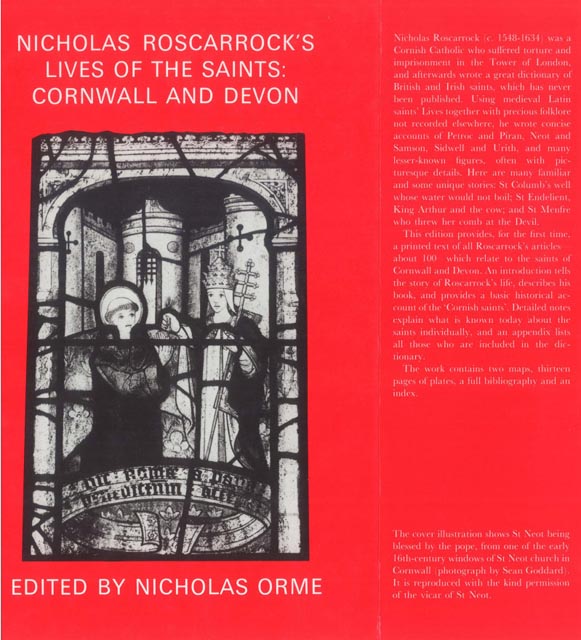Book contents
- Frontmatter
- Contents
- List of Text Figures and Illustrations
- Preface
- Introduction
- The Lives of The Saints: Cornwall And Devon
- Notes
- APPENDIX 1 A LETTER FROM F. WEBBE, 1640-1642
- APPENDIX 2 POEMS BY AND ABOUT NICHOLAS ROSCARROCK
- APPENDIX 3 AN INDEX OF ALL THE ENTRIES IN ROSCARROCK'S ‘LIVES OF THE SAINTS’
- APPENDIX 4 ROSCARROCK'S SOURCES; CORNWALL AND DEVON
- Bibliography
- Index
Introduction
Published online by Cambridge University Press: 05 August 2023
- Frontmatter
- Contents
- List of Text Figures and Illustrations
- Preface
- Introduction
- The Lives of The Saints: Cornwall And Devon
- Notes
- APPENDIX 1 A LETTER FROM F. WEBBE, 1640-1642
- APPENDIX 2 POEMS BY AND ABOUT NICHOLAS ROSCARROCK
- APPENDIX 3 AN INDEX OF ALL THE ENTRIES IN ROSCARROCK'S ‘LIVES OF THE SAINTS’
- APPENDIX 4 ROSCARROCK'S SOURCES; CORNWALL AND DEVON
- Bibliography
- Index
Summary
Nicholas Roscarrock was born in the middle of the sixteenth century at Roscarrock in the parish of St Endellion on the north-east coast of Cornwall. The house, which still exists, lies in a slight fold of the ground halfway between Port Isaac and Portquin, not far from the cliffs which form this part of the coast. In Tudor times Roscarrock was, and remains, a small manor house constructed round a courtyard, with farm buildings standing further off. From one side of the house there is a glimpse of the sea in Port Quin Bay, enfolded by the headland called The Rumps, but Roscarrock was not designed to enjoy the benefit of sea views. It turns its back on the waves, the storms and possible predators, and shuts them out at its rear with a battlemented wall. Instead, it faces south towards the land, with an exterior that is nowadays Georgian but preserves behind itself the remains of the medieval hall, with a roof of rafters and carved beams. If Nicholas returned, he would still find the roof of the hall, the south-west range or ‘chapel wing’ with its blocked-up Tudor windows, the courtyard, the fortified back wall and the well with its beehive shelter—all very much as he remembered them.
The Roscarrock family lived in this place from at least the end of the twelfth century, and took their surname from it. They thus possessed an ancient lineage—one of the ideal marks of Tudor gentry, and they had an adequate share of the others: wealth, status and power. Nicholas's father Richard (died 1575) held two of the five manors which made up the parish—Roscarrockmeur and Roscarrockvean, the great and the little Roscarrock—and his marriage to Isabel (died 1591), co-heiress of Richard Trevennor of Lamorran by the Fal estuary, brought him further property. He was important enough to be chosen as sheriff of Cornwall in 1550 and 1561, and he displayed a coat of arms to prove his gentility—'argent, a chevron between two roses in chief gules, and in base a sea-tench naiant azure', which is still to be seen carved on a bench-end (perhaps his own seat) in St Endellion church.
- Type
- Chapter
- Information
- Nicholas Roscarrock's 'Lives of the Saints'Cornwall and Devon, pp. 1 - 52Publisher: Boydell & BrewerFirst published in: 2023

